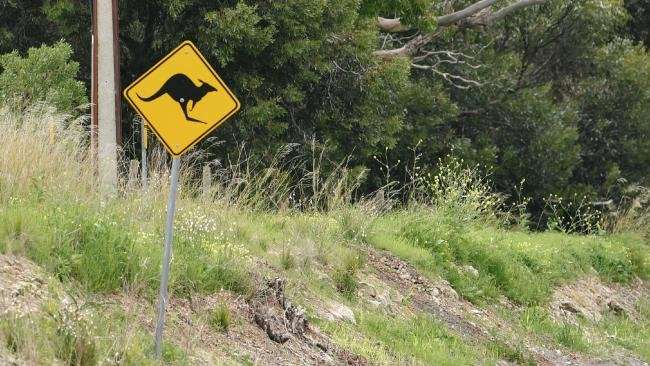Despite what American television would have you believe, the suburbs of Australia are usually kangaroo free. So imagine the surprise of witnesses who saw a roo bouncing merrily past a primary school on March 2. The marsupial was spotted in Heidelberg, in outer northeast Melbourne, in the early morning. Credit: Twitter/Andrew Leonard via Storyful
KANGAROOS are overrunning Australia and the population of the marsupials is double that of humans.
New government data shows Australia’s kangaroo population is close to hitting 50 million.
In 2016, there were almost 45 million kangaroos in Australia, compared to about 27 million in 2010.
It’s understood the huge rise in numbers in recent years is mainly due to environmental conditions; high rainfall has resulted in more food.
Experts are now encouraging people to hunt the Australian native animal and eat more kangaroo meat.
According to a report published by the Victorian Department of Sustainability and Environment, kangaroos are seen as national pests. They damage fences, compete with domestic livestock for food and water and trample crops.
Some kangaroos have also threatened humans in areas where they have been fed by members of the public.
Far west, NSW landholders told the ABC there were not enough incentives encouraging professional shooters to hunt kangaroos and believe the rising population of the animal will become unsustainable.
Garry Hannigan, from organic lamb farm near Broken Hill, Churinga Station, told the ABC he had noticed a boom in kangaroos.
“Two or three weeks ago we had thousands on here, just moving through, they were here in droves and the amount that are being hit by cars is amazing,” he said.
“They’re just devouring anything we’ve got grass wise, they’re starting to cause erosion along fences. Any of the grass country is just being pulled up by the roots.”
Decent rainfalls have allowed mobs to grow, with more food for them available, but Mr Hannigan said if the country experiences a lack of rain this summer, millions could die from hunger.
“In the next drought kangaroos are going to die by their millions,” he said.
In the 2000s Australia suffered through the worst drought since European settlement and experienced the driest years between 2006 and 2008.
In 2006 and 2007, the kangaroo population was down to just seven million.
The population reached about nine million in 2008.
It then jumped to about 11 million in 2011, when La Nina finally broke the drought.
David Paton, Associate Professor from the University of Adelaide, said communities needed to support kangaroo culling programs and eat their meat to avoid wasting carcasses.
“If we’re going to cull these animals we do it humanely, but we also perhaps should think about what we might use the animals that are killed for,” he told the ABC.
“We shouldn’t just simply leave them out in paddocks to rot of leave them in the reserves to rot.”
Professor Paton said Australia would lose a lot of biodiversity is we didn’t start to tackle the issue of the growing kangaroo population.
“It’s not the kangaroos’ fault they’re overabundant, it’s probably we’ve just been too reluctant to take a stick to them, remove them out of the system sooner, to actually prevent the damage being caused,” he said.

extremeanger on September 11st, 2017 at 04:51 UTC »
Can confirm. Went to Australia last year thinking, "Maybe I'll see a kangaroo. That would be a real highlight". Instead, saw hundreds of them. Just around Canberra, nowhere special, right near town.
Aisha9000 on September 11st, 2017 at 03:29 UTC »
Human population: 24 million
It seems strangely appropriate that Australia has more kangaroos than humans
redmedguy on September 11st, 2017 at 02:47 UTC »
So for all you non-Australians who are unfamiliar with Kangaroos:
While they're native, they're also a massive threat to agriculture, especially in such high populations as this. They are very hard to raise in captivity; so farming them is not very productive. Thus, when their population explodes after a period of relative wealth in the environment, it becomes deleterious to everything else.So, we solve it by eating them.
Roo is already fairly widely available in supermarkets these days; it's almost entirely wild-sourced.
I'd characterise it as being not unlike beef, though perhaps a little less dense, and considerably more lean. It has a stronger iron taste too.